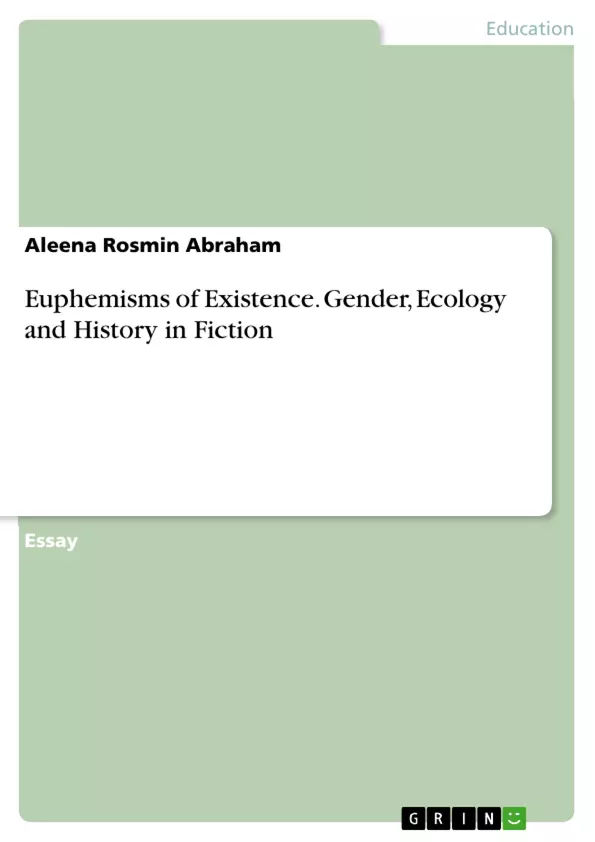This is an anthology of essays compiled under the general title Euphemisms of Existence: Gender, Ecology and History in Fiction. This collection consists of several essays concerning gender, ecology and history in the works of selected writers including Amitav Ghosh, Githa Hariharan, Shashi Deshpande and J.M Coetzee.
The fictional corpus of Amitav Ghosh has always been concerned with issues like gender, memories, history and ecology. If we closely analyze the patterns of Ghosh’s early and recent works of fiction, we can clearly trace a shift from history and memory to environmental problems and ecology. "The Shadow Lines" (1988) and "The Gun Island" (2019) will serve as a testimony for this statement.
The works of Githa Hariharan and Shashi Deshpande, to a great extent, deals with the issues of gender in patriarchal societies. Most of their characters are drawn from an Indian background and assimilate the plight shared by Indian women. Hariharan’s "The Thousand Faces of Night" and Deshpande’s "The Dark Holds No Terrors" are discussed here.
J.M Coetzee, a South African Nobel Laureate, in his works deals with the issues of gender in particular and discrimination based on caste, religion, race etc...in general. The essays in this book is an attempt to trace and locate how gender, ecology and history are explored in the works if this selected writers.
Inhaltsverzeichnis (Table of Contents)
- Redefining the Shadow Lines: A Reinterpretation of History Through Narratives
- Restructuring the Patriarchal Norms: Sarita as a Champion of Women Empowerment
- Merging the Shattered Selves: The Question of Self Realization in Disgrace by J. M Coetzee
- Euphemisms of Existence: A Reading of the Relationship Between Food and Gender
- Trauma Theory: A Retrospective Analysis
- Gender Stereotypes and Fairy Tales: A Reading
- The Thousand Faces of Night: A Reading of the Relationship Between Indian Myths and Gender Stereotypes
- Unearthing the Green Elements in The Hungry Tide
- HISTORY
Zielsetzung und Themenschwerpunkte (Objectives and Key Themes)
This anthology explores the intertwining themes of gender, ecology, and history in the works of select contemporary authors, including Amitav Ghosh, Githa Hariharan, Shashi Deshpande, and J.M. Coetzee. The essays delve into how these writers explore these complex topics within their narratives, highlighting their unique perspectives on societal structures, personal struggles, and the impact of historical events on individual lives.
- The Role of Narratives in Reinterpreting History
- The Representation of Gender and Patriarchy in Society
- The Exploration of Identity and Self-Realization
- The Interrelationship Between Food, Gender, and Social Norms
- The Intersection of Ecology and Human Experiences
Zusammenfassung der Kapitel (Chapter Summaries)
- Redefining the Shadow Lines: A Reinterpretation of History Through Narratives: This chapter explores how narratives serve as tools for reinterpreting history, focusing on Amitav Ghosh's The Shadow Lines. The essay examines how Ghosh's novel blends history and fiction, using first-person narration and non-linear storytelling to challenge traditional historical perspectives.
- Restructuring the Patriarchal Norms: Sarita as a Champion of Women Empowerment: This chapter delves into the portrayal of women's struggles in patriarchal societies through Githa Hariharan's The Thousand Faces of Night. The essay examines how the novel explores themes of female empowerment, social expectations, and the complexities of gender roles.
- Merging the Shattered Selves: The Question of Self Realization in Disgrace by J. M Coetzee: This chapter analyzes J.M. Coetzee's Disgrace, focusing on the protagonist's journey of self-discovery amidst societal discrimination. The essay examines how the novel explores themes of identity, guilt, and the search for meaning in a fractured world.
- Euphemisms of Existence: A Reading of the Relationship Between Food and Gender: This chapter investigates the symbolic relationship between food and gender in literature, highlighting how food can reflect social norms, power dynamics, and gender roles. The essay delves into the significance of food imagery and its connection to identity and self-expression.
- Trauma Theory: A Retrospective Analysis: This chapter explores the concept of trauma theory and its application in understanding the impact of historical events on individuals and societies. The essay examines how literary works can shed light on the enduring effects of trauma and the process of healing.
- Gender Stereotypes and Fairy Tales: A Reading: This chapter examines the perpetuation of gender stereotypes in classic fairy tales, analyzing how these narratives reinforce traditional gender roles and expectations. The essay critiques the underlying messages embedded in these stories and explores their impact on cultural understanding.
- The Thousand Faces of Night: A Reading of the Relationship Between Indian Myths and Gender Stereotypes: This chapter analyzes how Githa Hariharan's The Thousand Faces of Night weaves Indian mythology into its narrative to explore gender roles and societal pressures. The essay examines how the novel critiques traditional beliefs and challenges existing power structures.
- Unearthing the Green Elements in The Hungry Tide: This chapter delves into Amitav Ghosh's The Hungry Tide, exploring the novel's environmental themes and its depiction of the impact of human actions on the natural world. The essay examines how the novel highlights the interconnectedness of human and ecological systems.
Schlüsselwörter (Keywords)
The anthology delves into the complex interplay of gender, ecology, and history through the lens of literary analysis. Key themes include gender roles, societal structures, power dynamics, historical interpretations, environmental consciousness, and the human search for meaning and identity. The essays examine the works of notable contemporary authors, including Amitav Ghosh, Githa Hariharan, Shashi Deshpande, and J.M. Coetzee, exploring their narratives and their unique perspectives on these critical themes.
- Quote paper
- Aleena Rosmin Abraham (Author), 2019, Euphemisms of Existence. Gender, Ecology and History in Fiction, Munich, GRIN Verlag, https://www.grin.com/document/503688



